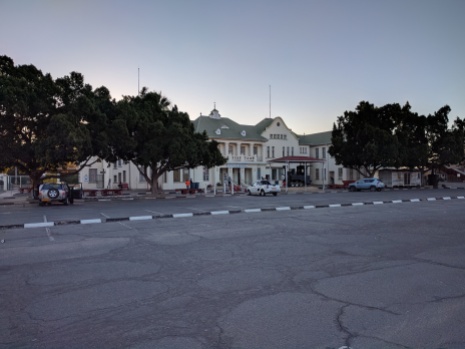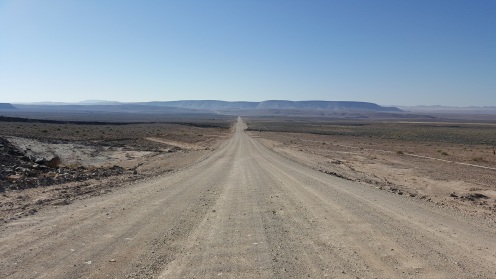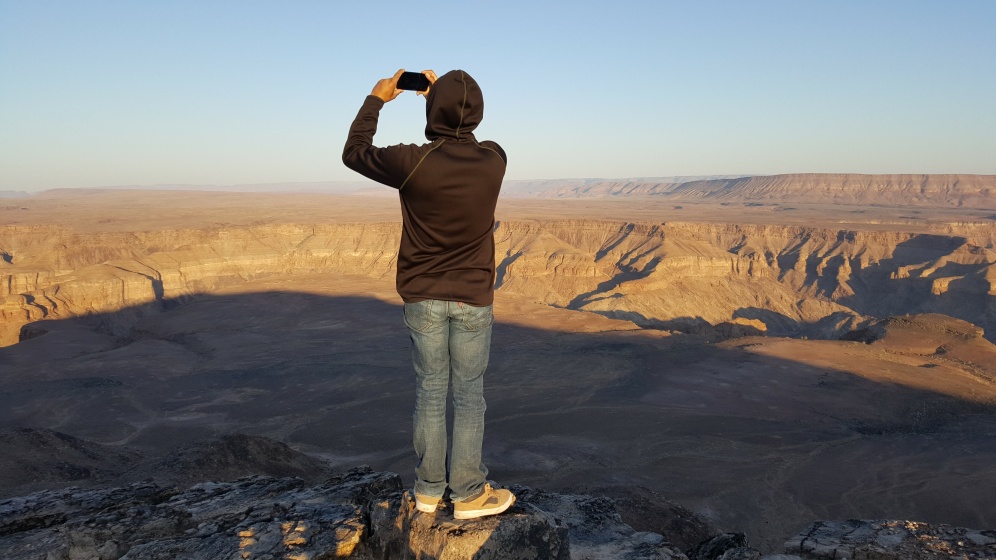After a lot of reading, research and talking to people finally ended up in our decision to self-drive in Namibia. There were fewer public transport options here, the roads longer and windy-er, and even though Namibia is the second least densely populated country in the world, road-fatalities are a record high (apparently second in the world…no-one knew who the first was). There was also quite a bit of conflicting information about whether a 4WD was necessary or if a sedan would be sufficient, what conditions the gravel and salt roads were in, the times when certain roads open/close etc. So finally we decided to do a 4×4, fully equipped with a tent on top. We also got a pretty good rate on the vehicle, which helped seal the deal.
We had three nights in Windhoek at the Chameleon Backpackers. Out first arrival into Windhoek on a quiet Sunday resulted in absolute jaws dropping at how clean the city is. Aside from the occasional candy wrapper and a bit of graffiti here and there, this was – BY FAR – one of the cleanest cities we had ever seen. We came to learn that Namibians are very proud of keeping their cities clean, and we kept being pleasantly surprised, as we made our way across the country.
During our time at the backpackers lodge, we spoke with a group of French visitors, who had driven 6000 km over a three-week span. We also met a lovely lady called Chrystel, who lives out of her Land Rover, lovingly named Maya. We learnt later that her beige Defender was unexpectedly, yet fittingly, named after a cartoon (which we didn’t get in Zambia/India/Kenya), called Maya the Bee, about a little optimistic bee who wanted to travel and explore the world. Chrystel has driven around Namibia for the last few months, and been back and forth several times in the last few years as well. She was very knowledgeable about the road conditions, places to visit, and we quickly adopted her as our unofficial trip planner. The night before we traveled, we made a last-minute change in our itinerary (from where the first destination would be), based on her encouragement and optimism about the possibility of whether we could actually do it or not, given our time constraints and lack of experience in the area. The newly revised itinerary was going to be from Windhoek down to Fish River Canyon (this was the last-minute addition), up through Helmeringhausen to Sesriem and Sossusvlei, north via Solitaire to Walvis Bay/Swakopmund (where we planned to rest for a few days), continue up following the Skeleton Coast to Springbokwasser, followed by Khorixas to Etosha (where we planned to spend two nights), down to Tsumeb and Grootfontein and finally drive back south to Windhoek to catch our bus to Cape Town. That would cover a good 3,600 km through all of the places on our list.
The trip started off on the 31st of May, with us waddling from our hostel with all our luggage, to the car rental agency. We completed the formalities, followed by a quick briefing/training on where everything was in the vehicle and how we were meant to use it. We were told of many things we should be sure to do, and plenty more that we shouldn’t. Shweta started getting nervous that we weren’t taking copious notes, just as we were reassured that a majority of the information was in a folder in the car. We loaded up our luggage, our first stop naturally being the grocery store – camping meant we would need to cook our meals. We also had to rectify a camera issue we had…the issue being that we didn’t carry our large camera due to weight/volume restrictions that come with backpacking, and our small camera is currently safe, untouched, and gathering dust, in a storage unit in Houston (moving/packing can be confusing). We’ve been making do with our cell phones, but they make it seem as though everything is at least 17 miles away from us. Hopefully the new camera means better pictures for our future posts.
With food and other essentials put away, our second stop was also an equally mundane petrol station – our mobile tent needed sustenance too. Once both us and our vehicle were satisfied with the supplies, we hit the B1 highway towards Keetmanshoop. This highway is the main North-South highway running all the way from Angola to South Africa, however you would never guess this while on it. There was very little traffic, and the cars were few and far in between. The road was well maintained, but not too different from any other well-maintained highway. Every once in a while we would go over small hills and the view would open up, gloriously showing off the plains and mountains of central Namibia. The landscape, especially the higher parts, were dotted with strange structures that looked like boxy grain silos. Turned out these were communication towers that, from the look of it, had been retrofitted with newer antennas stuck on top. We passed through the country quite quickly and made very good time down to Keetmanshoop where we stopped to stretch our feet.
The road out of Keetmanshoop took us a bit west, and then we turned onto a gravel road south-wards towards Fish River Canyon. This was by far, the most well maintained gravel road we had ever seen. The road was in better condition than most tar roads, some highways, and of far higher quality than everything in Uptown New Orleans! As we continued kicking up dust down the road, we passed through dry plains and small hills. During one of these descents, we came across a huge patch of greenery, which was a little baffling, given the parched landscape we had been passing through. This turned out to be a plantation project with palm trees and a vineyard. There were neat rows of grapevines growing all the way to the horizon, corralled by tall trees presumably to protect from the winds. This, we later found out, is the Naute Dam Irrigation Project. The water from the dam has turned barren and infertile land into a productive agricultural zone that produces a variety of fruits. Unfortunately we could not stop and have a closer look since we were trying to beat the sun to our campsite to avoid night-driving.
We arrived at the Hobas campsite a little after sunset having had to drive a few harrowing miles through the dark. We did not do much that night, the long drive had drained us of energy, and the temperature had dropped dramatically after the sun’s escape. A quick cup-o-noodles dinner, and necessary hot water bottle preparations later, we went to bed with the knowledge that the next morning would be an early one to catch the sunrise at the Canyon.
Being up at 5-5:30am multiple days in a row can be a drag, but when the motivation is of the right kind, the coefficient of said drag is dramatically reduced. We were up and driving towards the canyon in the hazy dawn light. We drove up a gentle slope towards the main viewpoint, and as we went over the crest, the ground dramatically dropped off in front of us. This first sight of the canyon was truly awesome, not in the modern sense where prosaic everyday items – like a latte – takes one’s breath away, but rather in the involuntary exhalations that accompany true delight. The Fish River Canyon is the largest canyon in Africa and second only to the Grand Canyon in the world. Having never been to the Grand-er one, this, at least to me, was the largest I’ve seen. We parked the car and started walking towards one of the other view points but quickly realized that we wouldn’t beat the sun, and that what we saw wasn’t a walking-only path. So we ran back to the car and drove to the next viewpoint for the sunrise, a short walk over and we were at a meander in the canyon from where the canyon spread out in front of us in all it’s glory. The terrain was cluttered with rocks and gravel in a variety of grading. We walked over to a rock outcropping and watched the sun rise over mountains in the distance.
As the sun rose behind us, the shadows lazily retreated from the advancing light, slowly ebbing over the plains and crawling down the opposite sides of the canyon. Every fold in the canyon wall took advantage of the sun peaking over the horizon, casting long shadows along its side as every edge turned to solid gold. As the sun marched over the horizon, the colorful sky lost its orange and purple hues and had settled on a clear blue. With the light came much-needed warmth, almost as immediately as we had lost it the night before. We walked around the rock strewn cliffs for a while, finding new nooks in the canyon walls, catching glimpses of the river below between the outcroppings.
While making our way across the top of the canyon, there were four posters where we had read about the canyon’s history. The flora found in the canyon is unique to many other locations. One of these, the Quiver tree, which was previously used to make arrows for hunting purposes, was truly something that came out of Dr. Seuss book. It was a spiky, caricature of a tree, with a golden base that glowed in the sun. We found more of these trees on our further drives, but they don’t grow in groves at all….we were lucky to find one every few kilometers.
Our trip to the Fish River Canyon ended with a breakfast of champions – cereal (Cocoa Pop Crunchies, specifically) and milk – with one of the best views we have ever had. It was a great start to the morning, before we headed over to the dunes further north of us.






































It’s great reading all these posts!! The engineer in Vivek makes the posts very detailed, feel like I’m there with you guys! Enjoy the rest of Africa! What/when is next destination? Hope the both of you are doing well!
LikeLiked by 1 person
We’re doing well, been very interesting so far. Currently in Cape Town, planning to get over to Mozambique, then probably Kenya next.
LikeLike
Glad you’re following us! So, yeah, a few more weeks before we head to Europe. How’re QB, Kabir and Meera? Lots of love from our side.
LikeLike
Hi Shweta n Vivek, wow such beautiful scenery n great writing, I felt like I was reading a great book. The African sun looks so warm n inviting. I can’t wait to visit these beautiful countries. Please keep writing n print a book so we can refer to it when we decide to follow your footsteps( ofcourse remember our steps are slower with age😉). Enjoy your journey n stay well. Lots of love to you both.
LikeLiked by 1 person
Glad you’re following us, Masi. It’s been such a treat to see so much beauty a step away from home. We will have many recommendations for you, not to worry – all you need to do is go there! Love you!
LikeLike